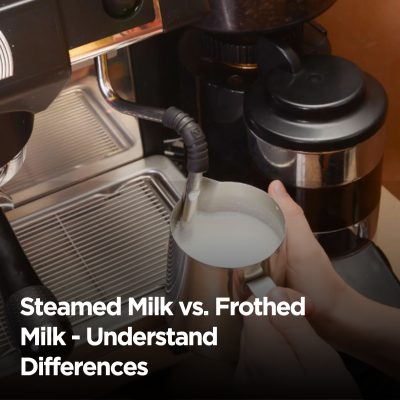Coffee is something that everyone craves. This is why coffee hiked by 58.74 USD per pound or 18.33% since the beginning of 2025. However, not all coffees are the same, and one of the notable differences is their milk.
If you’ve ever ordered a cappuccino or a latte, you’ve probably noticed the difference in milk texture. But do you know what makes them distinct? Many coffee lovers hear terms like steamed milk vs. frothed milk without fully understanding how they differ.
Both are essential in making espresso-based drinks, but there is a considerable difference between steamed milk and frothed milk because of their textures and drinking experiences. That’s why your latte feels creamy, while a cappuccino has a thick, frothy layer on top.
This article will give you all the insights to differentiate steamed vs. frothed milk. Let’s start with some basics.
What is Steamed Milk?
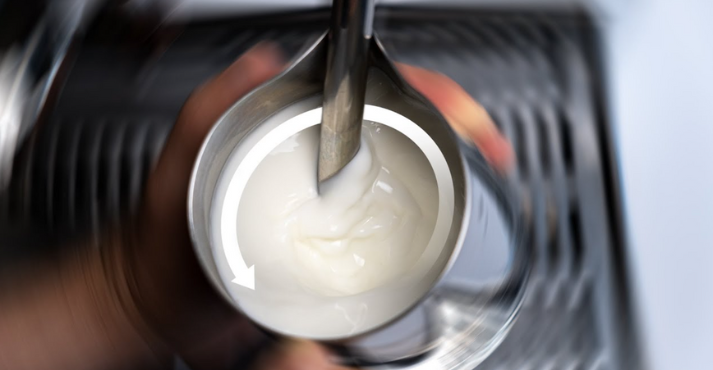
Steamed milk is milk that has been heated while introducing minimal air. This process creates a smooth, velvety texture with fine air bubbles known as microfoam. Microfoam creates all the difference between steamed milk and frothed milk. Unlike frothed, airy, and foamy milk, steamed milk is heavier and blends seamlessly with espresso.
Steamed milk is used in different types of coffee, including lattes, flat whites, and café au lait. It enhances the overall taste and texture of the drink for a rich and creamy experience.
How to Steam Milk?
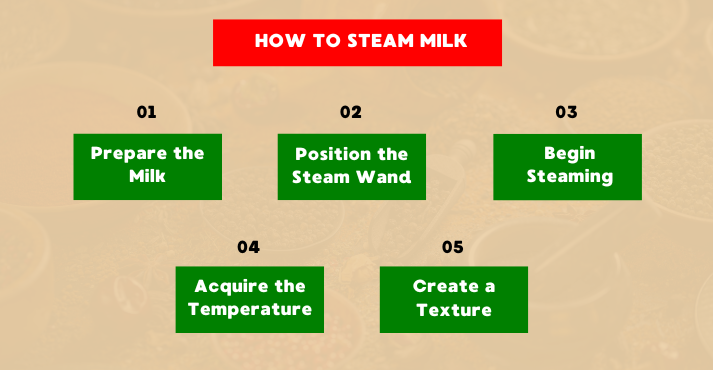
Milk is typically steamed using a steam wand built into many coffee machines. Most coffee machines, like the espresso machine, have this steam wand. Steaming milk requires careful technique to achieve the right temperature and texture.
*You can also use a separate stand-alone steam wand if a coffee machine does not have a built-in steam wand
To do the real magic below your Latte art, below is the step-by-step process for preparing steamed milk.
Step 01 – Prepare the Milk
Start with fresh, cold milk. Whole milk is preferred because of its fat content, which improves the texture. Pour the milk into a stainless steel milk pitcher, filling it about one-third to allow room for expansion.
Step 02 – Position the Steam Wand
Place the steam wand just below the surface of the milk. It should not be too deep, as that would only heat the milk without creating microfoam.
*Large bubbles will form instead of the desired fine-textured foam if it is too close to the surface.
Step 03 – Begin Steaming
Turn on the steam wand and let air incorporate into the milk for a few seconds. A soft hissing sound indicates that air is being properly introduced. Once the milk slightly expands, lower the wand deeper into the milk to continue heating without adding excess air.
Step 04 – Reach the Ideal Temperature
The milk should be heated to a temperature between 55-65°C (130-150°F). If the milk overheats, it loses its natural sweetness and develops a burnt taste.
Step 05 – Create a Smooth, Velvety Texture
Once the milk reaches the ideal temperature, turn off the steam wand. Tap the milk pitcher lightly on the counter to remove large bubbles. Swirl the milk gently to ensure an even consistency.
How to Steam Milk Without Espresso?
If you don’t have an espresso machine with a built-in wand, you can achieve your desired texture by steaming milk by hand.
There are different ways to steam milk without a steam wand.
- You can steam milk in the microwave after whisking.
- Use a French press and plunge the handle up and down several times.
- Use a Hand whisk or electric milk steamer after heating the milk on the stove.
What is Frothed Milk?
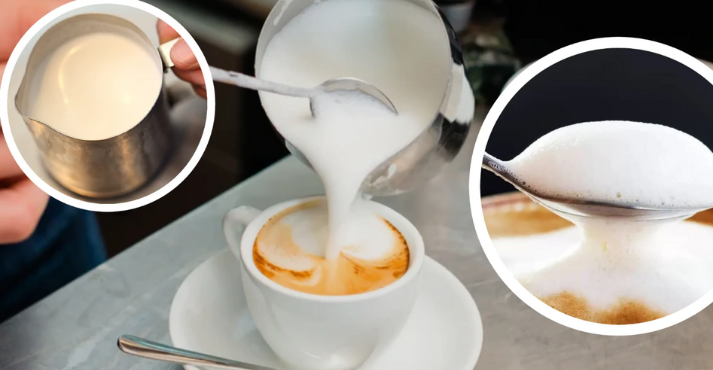
Frothed milk is aerated milk transformed into a light and airy foam. This is what distinguishes frothed vs steamed milk. It differs from steamed milk because it incorporates more air, creating a thicker, more voluminous foam with larger bubbles.
Because of its airy texture, frothed milk holds its shape and is often used to create distinct layers in coffee beverages like cappuccinos, macchiatos, and specialty coffee drinks.
How to Froth Milk?
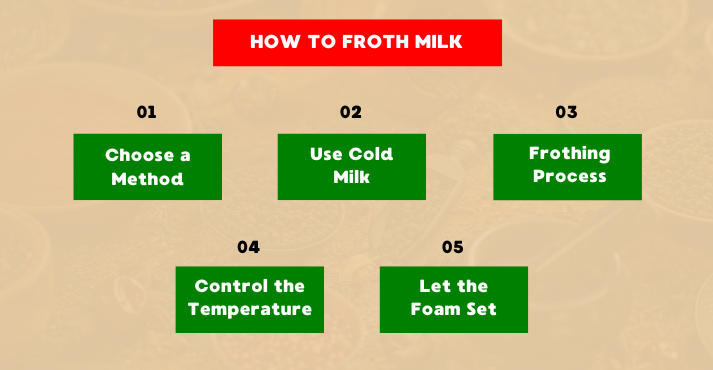
Milk can be frothed using a steam wand, a handheld frother, or manual methods such as shaking milk in a closed container. Introducing as much air as possible while maintaining stability is the key to frothing milk.
Step 01 – Choose a Frothing Method
The easiest way is to use an espresso machine. But milk can be frothed using various tools. A steam wand is commonly used in professional settings, but handheld frothers, electric frothers, or even simple manual methods can achieve similar results at home.
Step 02 – Use Cold Milk
Choose your milk wisely. Cold milk froths better than warm milk. Whole milk creates a thicker foam, while lower-fat and non-dairy alternatives produce a lighter texture.
Step 03 – Frothing Process
If using a steam wand, position it near the surface of the milk to introduce more air. A handheld frother whisks the milk quickly, creating foam without heat. The more air incorporated, the frothier and thicker the milk becomes.
Step 04 – Control the Temperature
Frothed milk can be either hot or cold. It is best kept slightly cooler than steamed milk to maintain its airy texture if heated.
Step 05 – Let the Foam Set
Once frothed, allow the foam to rest for a few seconds to stabilize. This helps it maintain its shape when added to a coffee beverage.
How to Froth Milk Without Espresso?
Besides the espresso steam wand, a manual frother can be used to froth milk. You can use:
- Handheld frothing wand
- Electric Milk Frothers
- Hand whisks
- Immersion blender
Steamed Milk vs. Frothed Milk – Key Differences
Both steamed milk vs. frothed milk play an important role in coffee preparation, but they differ in texture, preparation method, and overall characteristics. Let’s uncover the difference between steamed milk and frothed milk to help you choose the correct milk technique for different coffee drinks.
1. Texture
Texture is one of the most prominent differences between steamed milk and frothed milk. Steamed milk has a smooth, velvety, and dense texture with microfoam. Microfoam popups tiny air bubbles that create a creamy feeling in the mouth. This makes it ideal for lattes and flat whites, where the milk blends seamlessly with espresso.
Frothed milk, on the other hand, is light, airy, and foamy, with larger bubbles that create a more pronounced foam layer. It is less creamy and forms a drier, stiffer foam, perfect for cappuccinos and macchiatos.
*The texture is also influenced by the type of milk you use. Head to the next section for detail on this.
2. Preparation Method
Steamed milk is created by injecting hot, pressurized steam into the milk using a steam wand. This process simultaneously heats and aerates the milk, giving it a velvety texture.
Frothed milk is made by introducing more air into the milk using a steam wand, handheld frother, or manual methods like shaking milk in a container. This increases the volume of the milk, creating a thick layer of foam.
3. Temperature
Steamed milk is always hot, typically heated to 55-65°C (130-150°F). The heating process enhances the milk’s natural sweetness and smooth texture.
Frothed milk can be either hot or cold, depending on the method used and the type of drink it is being prepared for. Cold frothed milk is often used in iced coffee drinks, while hot frothed milk is standard in cappuccinos.
4. Water Content
Steamed milk is more watery and liquid-like due to the introduction of steam. This allows it to blend effortlessly with coffee types like Latte, creating a balanced taste.
Frothed milk is drier and more aerated, with more air incorporated. This concludes as a stiff foam that sits on top of the drink rather than blending into it.
5. Stability
Another rich difference between steamed milk and frothed milk that sets them apart for different coffee types is their stability. Steamed milk has a delicate foam that is less stable. It integrates smoothly with Latte and cannot hold its shape for long.
Frothed milk has a more stable foam that holds its shape better, making it ideal for beverages where a thick layer of foam is needed (such as cappuccinos).
Choosing the Right Milk for Steaming and Frothing
The type of milk used plays a crucial role in achieving the desired texture for steamed vs. frothed milk. Different milk types produce different levels of creaminess and foam, affecting the overall quality of coffee drinks.
Whole Milk
Whole milk is the best option for creating a rich, creamy, and velvety texture. It contains the right balance of fat and protein, making it ideal for lattes and cappuccinos. The foam is smooth and stable, enhancing both taste and presentation.
Low-Fat and Skim Milk
Low-fat (2%) and skim (non-fat) milk produce lighter, airier foam. Skim milk, in particular, creates a dry, airy foam with a thin texture, making it suitable for drinks like bone-dry cappuccinos. However, it lacks the creamy body that whole milk provides.
Non-Dairy Alternatives
For those who are lactose intolerant or prefer dairy-free options, several plant-based milks can be used for steaming and frothing:
- Soy Milk – A popular alternative with good protein content, creating stable foam.
- Oat Milk – Naturally creamy and ideal for lattes, with a slightly sweet flavour.
- Almond Milk – Produces light foam but may separate when heated.
- Coconut Milk – High in fat and provides a rich, thick froth.
*It is best to use carton coconut milk rather than canned, as canned versions may be too dense for frothing.
*Each milk type has unique steaming and frothing properties, so it is recommended to opt depending on the desired texture and personal preference.
Best Practices for Steaming Milk
People often neglect some crucial points to properly steam milk and create the intended texture. To draw a clear line of difference between steamed milk and frothed milk, below are some best practices to steam milk with perfection:
- Fresh, cold milk creates the best texture because it allows more time for air incorporation before reaching the ideal temperature. Cold milk also helps maintain the natural sweetness of the milk when heated properly.
- The position of the steam wand is crucial. Keep your steam wand just beneath the surface of the milk to ensure tiny, uniform air bubbles, creating microfoam. If the wand is too deep, the milk will only heat up without forming a proper texture. Large bubbles will form if it is too close to the surface, leading to uneven foam.
- Tilting the milk pitcher slightly helps create a swirling motion, evenly distributing the air throughout the milk. This process helps prevent large bubbles and ensures a consistent, silky texture.
- After steaming, gently swirl the milk pitcher to integrate the microfoam and remove any remaining air bubbles. This step enhances the texture and ensures the milk pours smoothly into the coffee.
- Overheated milk loses its natural sweetness and can develop a burnt or scalded taste. Sticking to the ideal temperature range ensures a balanced and enjoyable coffee experience.
Best Practices for Frothing Milk
The Do’s and Don’ts flip in steamed milk vs. frothed milk. What is recommended in steam milk is usually a disaster in forthing milk. Let’s see the best practices for forthing milk to perfection.
- To achieve a thick, airy foam, position the steam wand near the surface of the milk. This allows more air to enter, creating larger bubbles that give frothed milk its signature light and fluffy texture.
- If using a steam wand, pulsing the air introduction in short bursts rather than a continuous stream helps control the foam’s consistency. This prevents excessive bubbling and ensures even aeration.
- After frothing, gently tap the milk pitcher on a countertop to pop any large bubbles. Swirling the pitcher afterward helps integrate the foam and milk for a balanced texture.
- A handheld frother is an excellent tool for those who do not have a steam wand. It quickly whisks the milk, incorporating air to create a foam. Electric frothers can also heat and froth milk simultaneously for convenience.
- Frothed milk is best kept slightly cooler than steamed milk. Overheated frothed milk can cause it to lose its airy texture and collapse, affecting its ability to hold its shape in a coffee drink.
- Allow the foam to settle for a moment. It helps stabilize the bubbles, makes pouring the frothed milk easier, and maintains its structure in the cup.
Conclusion
Steamed milk vs. frothed milk comes with different preperature methods, resulting in a unique texture and feel for coffee beverages. Next time you prepare a particular coffee, remember the steps and best practices that we just discussed to get the best of your desired texture and experience.
For more tips and tricks related to all things food and hospitality-related, stay connected with FHA HORECA.

